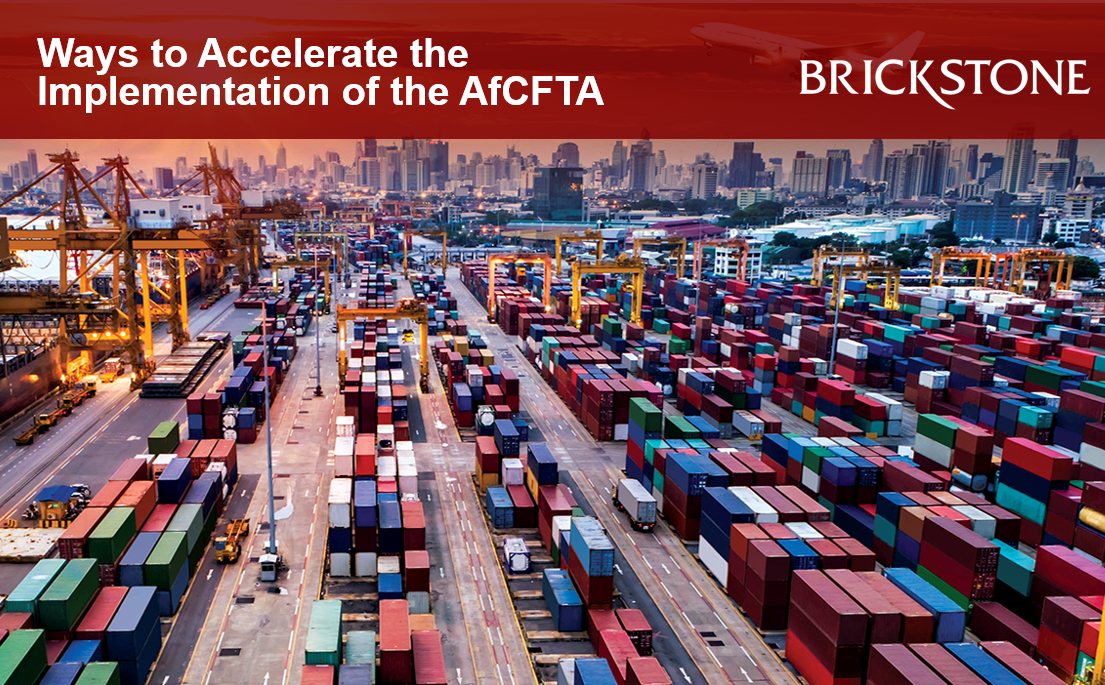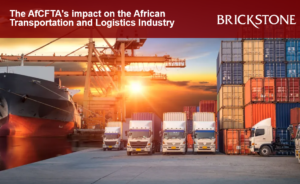Ways to Accelerate the Implementation of the AfCFTA
The AfCFTA, founded on the 21st of March, 2018, is one of the Flagship Projects of Agenda 2063 Africa’s development framework.
It is a free trade area encompassing most of Africa, aimed at boosting intra-African trade, and enabling African countries to proactively and swiftly respond to the twin green and digital transitions Africa faces in the 2020s. The flagship, if fully harnessed, houses enormous opportunities and potential such as positive economic outcomes, job creation, poverty reduction, and improvement of the quality of life of the people.
This article by Brickstone reviews some institutional reports on how to accelerate the implementation of the AfCFTA.
7 Ways to Accelerate the Implementation of the AfCFTA
According to the World Economic Forum, accelerating the implementation of the African Continental Free Trade Area (AfCFTA) would provide the region with much needed stimulus and drive the region’s long-term recovery and growth.
Deeper integration of the AfCFTA would boost incomes, create jobs, catalyze investments, and facilitate the development of regional supply chains.
The Cooperative Logistics Network affirmed that the implementation of the African Continent Free Trade Agreement (AfCFTA) as at 1st January 2021, allowed the African nations to officially commence trade under a new free trade area across the continent. It has also created the largest free market in the world by connecting 1.3 billion people from 55 nations with a total GDP of $3.4 trillion.
Although the AfCFTA has realized this much, more still needs to be done to harness its full potential. In lieu of this, the World Bank estimates that, if implemented properly, by 2035, the AfCFTA is set to lift 30 million Africans out of extreme poverty and 68 million from moderate poverty. The same study finds that the AfCFTA has the potential to increase intra-African trade by 81% and boost wages by 10% by 2035.
Brookings and the United Nations recommends the following ways to accelerate the implementation of the AfCFTA, making it a functional agreement:
Trade should not wait until the outstanding rules of origin surrounding textiles and clothing, automobiles, and sugar (which constitute only around 12 percent of the total traded products) are resolved. Also, African Member States are encouraged to maximize the momentum created by the start of trading under the AfCFTA to conclude negotiations on the second phase of the process, harmonize trade policies and promote sustainable infrastructure and industrial development.
Capacity building and institutional support are key to enabling African countries to harness the potential of the AfCFTA and benefit from expanding international trade flows. It is imperative to further build trade and productive capacities and implement industrial policies to increase added value in manufacturing and create decent jobs for Africa’s burgeoning population of young people.
More public awareness campaigns should be conducted to publicize national and regional AfCFTA strategies created by signatory states, through various social and traditional media platforms. This will help in raising awareness about the AfCFTA among all stakeholders such as chambers of commerce, private sector associations, and the general public.
Simple operational steps should be taken to visibly accelerate the implementation of AfCTA. For instance, encouragement of the logistics and supply chain industry to use AfCFTA documents for their operations, customs authorities insisting on companies registering for exportation under the AfCFTA rules of origin, and member states of regional economic communities with functioning free trade areas agreeing to add the AfCFTA logo to the customs documents used for regional trade. The adoption and execution of these actions will demonstrate to all traders that the AfCFTA is operational.
There needs to be a “demonstration effect” once the AfCFTA is implemented to prove that it can quickly foster greater intra-African trade. Many countries that have already ratified the agreement have contiguous borders. Tariff reductions could quickly lead to enhanced trade between these neighboring countries.
The AfCFTA holds significant potential for promoting more inclusive sustainable development, including through advancing women’s economic participation. The AfCFTA Agreement emphasizes the importance of gender equality for the development of international trade and economic cooperation and underscores the need to promote sustainable and inclusive socio-economic development, gender equality and structural transformation.
Read more here.
Why not contact us to make your Project Happen
Our advisors and consultants would be able to schedule an online meeting with you to discuss your project with the overall objective of seeking ways to achieve the “bankability” and protection of the long term asset value of your project. Request a Meeting Now






